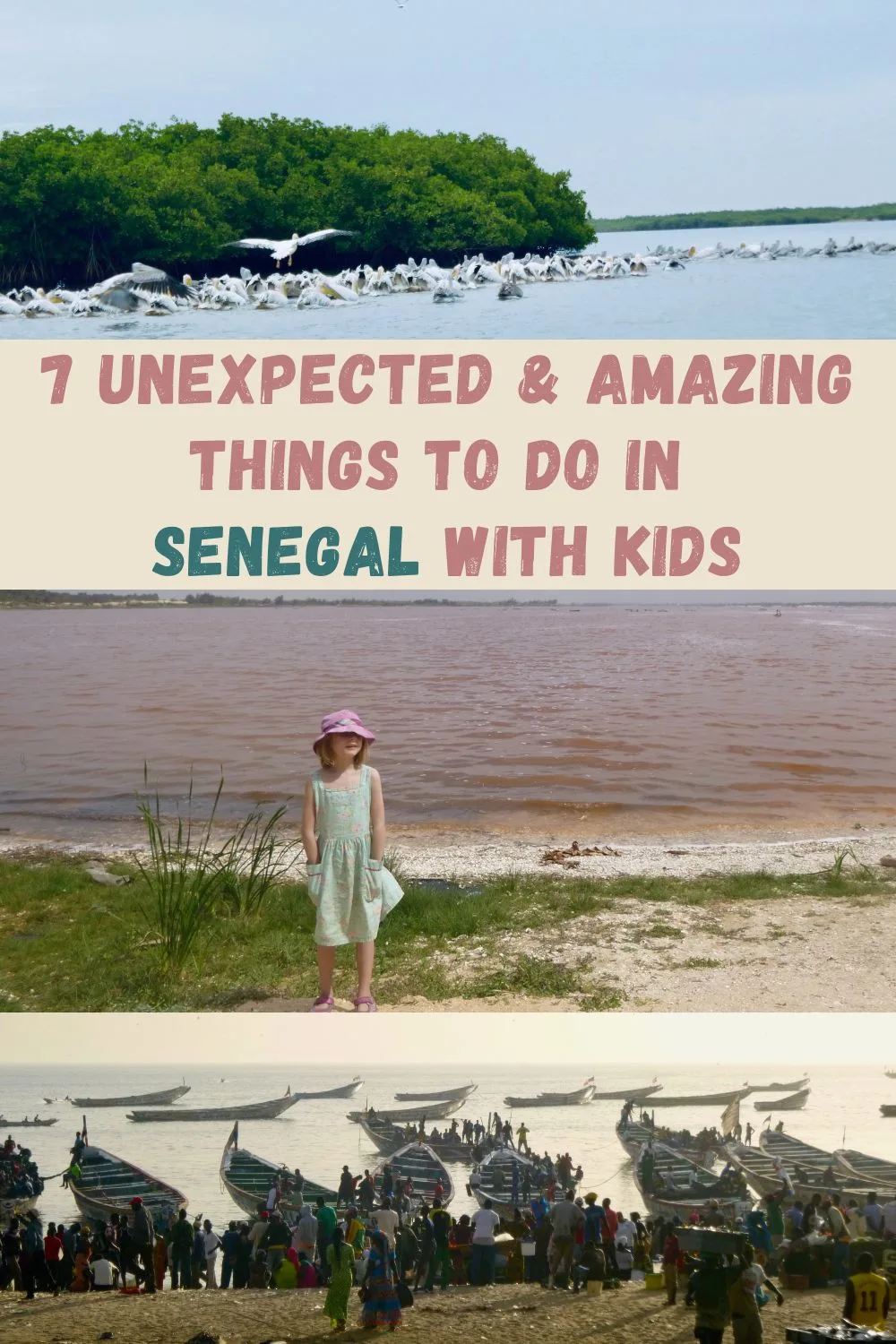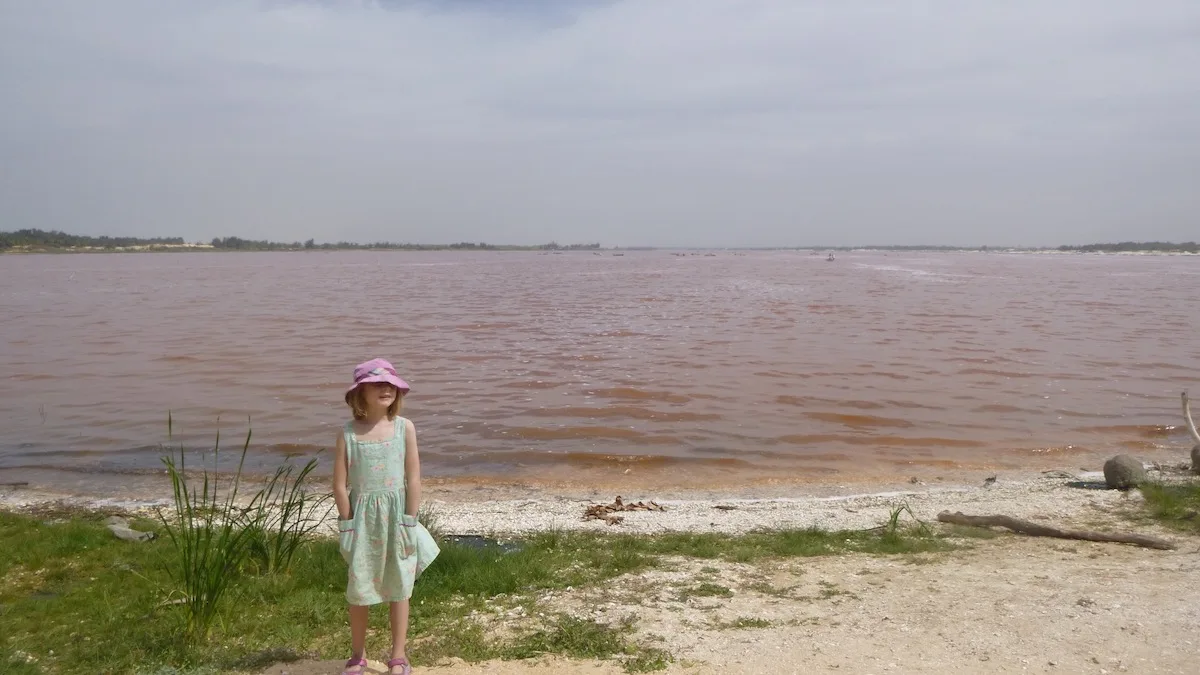Senegal, on Africa’s Sub-Saharan west coast, absolutely plays second fiddle to the Southern African countries famous for their safari vacations. But it’s safe, affordable and accessible, making it a good place for U.S. and European families to get their first taste of sub-Saharan Africa.
For starters, it has nice beaches, a complex history and fun things to do with kids, plus several UNESCO world heritage sites. The food is far more accessible than I expected. Moreover, it requires a much shorter plane ride than those southern African countries.
We visited Senegal for a week over Christmas break and were lucky enough to be hosted by a friend who has been traveling there for much of his life. He did all the activity organizing for us, giving us a good insider’s view of the best things to see and do.
We focused our time on the strip of coast between Dakar and the Gambian border, a part of the country has a good variety of things to do.
You might also like
• 5 Things To Do Before Taking Kids To Africa
• What to Expect on An Africa Safari With Kids
• A Vacation in Guadeloupe,
where many enslaved Africans were sent from Senegal.
7 Unique Things to Do, See & Eat With Kids in Senegal
Swim in a pink salt lake
Visiting Lac Rose was easily the most memorable part of the trip for all of us, especially for Tiny Traveler. It’s an extremely concentrated salt lake with algae that make the water look pink (really pink!) when the sun hits it.
It was actually a bit overcast the day we visited but even then you could see the distinct color of the water.
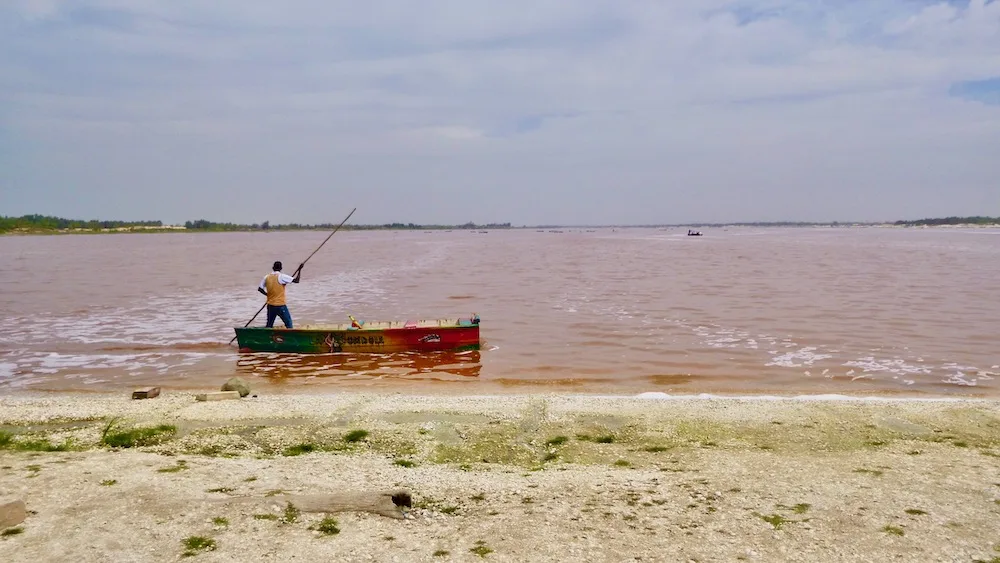
Swimming in Lac Rose (also called Lake Retba) is a must. The water is thick to paddle through, and even sitting cross-legged you bob like a cork. The restaurant where we ate had basic changing cabins. There is a fresh water shower nearby where you can rinse the salt off; if you don’t, the salt can irritate your skin make you itchy.
Tip: Skip shaving that morning or the salt water might be more bracing than you would prefer.
After our swim, we took a ride around the lake in a 4-wheel-drive truck. We got to see the salt harvesting. The lake is so densely salted that some of the salt settles to the bottom. So the local people go out in small pirogues to skim it from the bottom of the lake and pile it on the shore to dry it out.
The salt air is pretty corrosive and the trucks get pretty beat up. Ours stalled briefly in one of the lakeside villages and kids immediately poured out of the houses to check us out while the drivers tended to it.
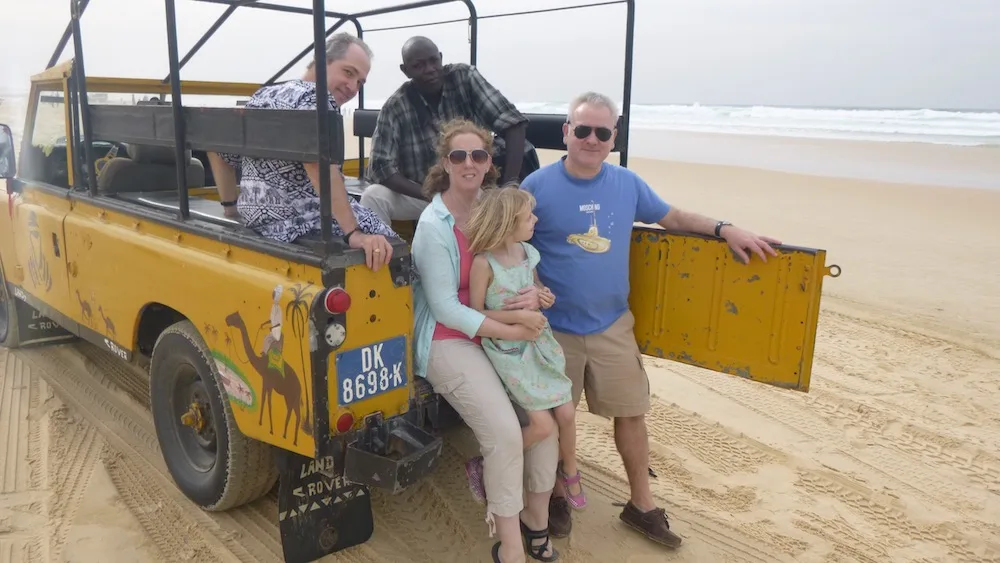
We passed through a traditional village and rode over sand dunes along the nearby coast, which wasn’t quite what I thought it would be. We were jostled and bounced quite a bit going over the dunes; kids need to be able to hold on tight and I’m not sure how much Tiny Traveler actually enjoyed that part.
There’s a restaurant and changing area and souvenir store where the trucks start and finish.
We bought a picture of the salter harvesters out on the lake that was made by a local artist from different colors of sand, a unique souvenir.
The adults had grilled fish and curried goat at the restaurant. Tiny Traveler had what she had everywhere we went: grilled chicken legs and rice. They almost always have French fries, too, but to my surprise, my kid preferred the rice.
All taken together, it was a unique and really enjoyable day.
Go Birdwatching in a Big Way
Even without safaris, wildlife viewing is one of the best things to do in Senegal.
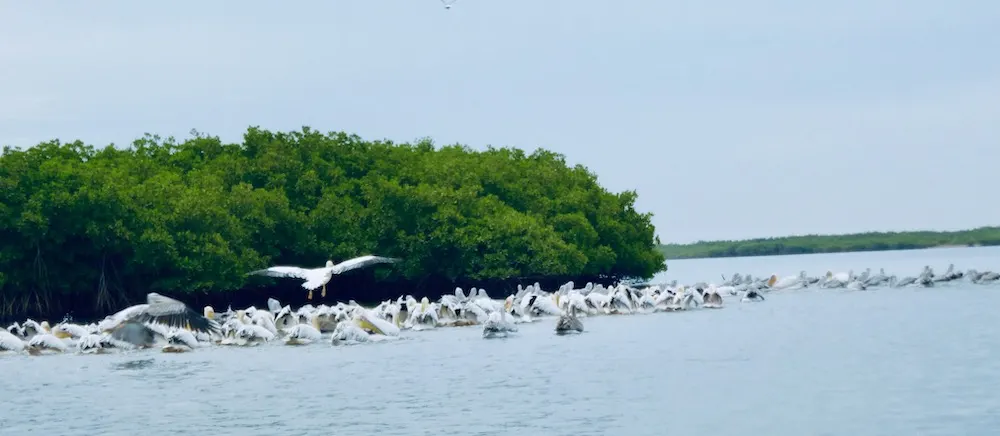
One of the highlights of our trip was hiring a small motored pirogue for a ride around the Sine-Saloum Delta, a UNESCO site near the Gambia border. I’d previously only ever seen pelicans and herons solo or in pairs. Seeing giant flocks of them along with egrets, herons and other birds was spectacular. We even a mongoose lurking in the mangroves.
I was concerned Tiny Traveler might get bored quickly since birds don’t do much. But the boat was fun, and she was impressed enough with the sheer number and variety of birds to take out her notebook and write down everything we saw. Boats leave from Ndangane for bird watching and fishing.
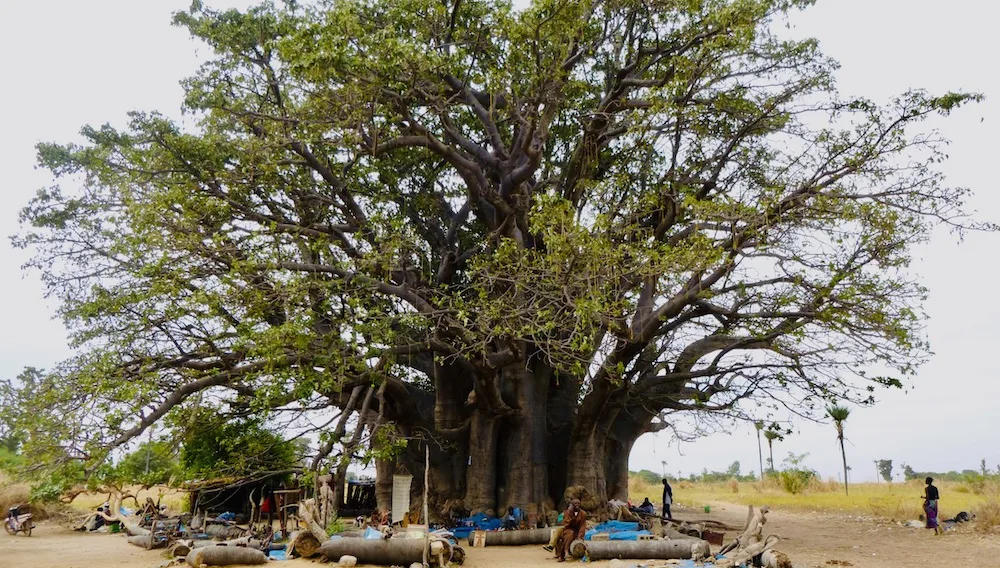
On the way home we stopped for photos at a particularly old Baobab tree. It was tall and fat enough to have a small crafts market going on underneath it. You’ll see these distinct baobab trees in various sizes all over Senegal and nearby countries. They’re cool to look at and kids like to climb around the roots of the larger ones like this one.
They make a drink with baobab fruit, but it’s often flavored with orange blossom, which is too flowery for my taste. Try it if you have a chance to, though.
Lunch: On the way back to our house we stopped for an al fresco lunch near the footbridge that connects both side of Joal-Fadiot. The town is famous for its integrated cemetery. You’ll see sections of tombstones with Muslim crescent moons next to clusters of Christian crosses. The Senegalese take a lot of pride in this the tangible expression of religious coexistence.
The houses in the village are whitewashed and made with cochina, a super-strong cement embedded with sea shells, similar to what the Spanish built with in colonial St. Augustine, Fl.
The Catholic church is bright, filled with light and color and felt like a joyful place. It’s a shock if you’re used to Europe’s dark, imposing cathedrals. If you practice, you might want to visit to join in a Sunday service.
It’s common to combine Sine Saloum, Joal-Fadiot and the Baobab into a one or two-day trip.
Tip: If you eat out in Ndangane, Palmarin or Joal-Fadiot, look on the menus for the oysters that grow wild on the Sine Saloum mangrove stalks.
Explore Some Difficult history
Senegal and neighboring Gambia were central to the trade of enslaved Africans. There are preserved remnants of that dark past on Ile de Gorée, another UNESCO site, just off the coast of Dakar.
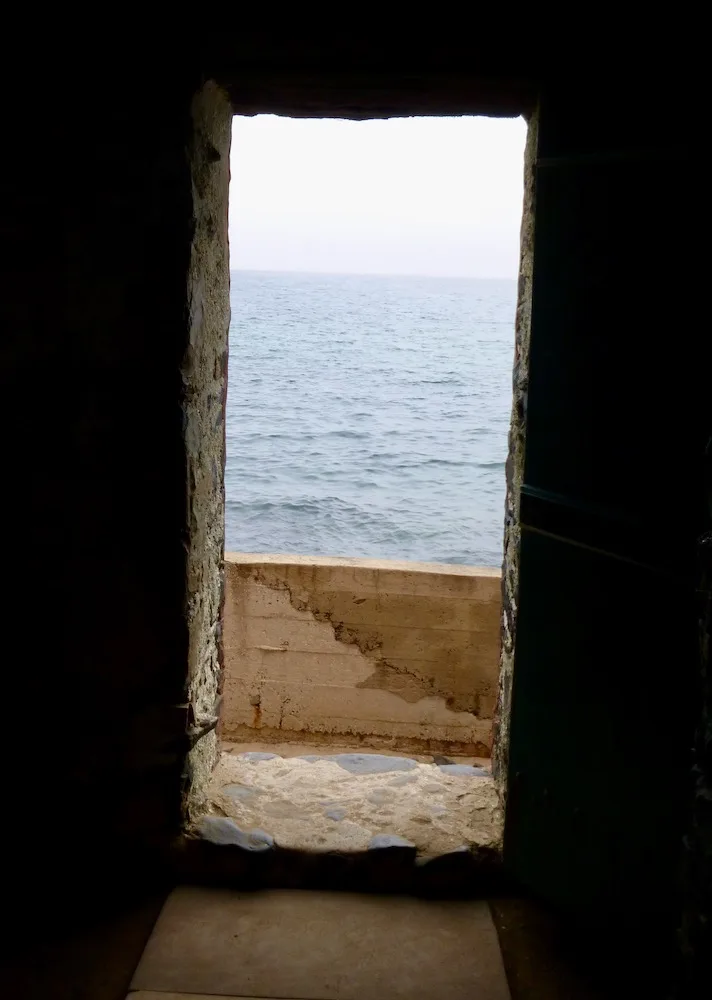
The American history most of us learn doesn’t look at where and how the journey of the enslaved Africans began. I think it’s as essential confront this part of our past, as unsettling as it is. It’s akin to visiting Dachau in Germany or Tuol Sleng in Cambodia.
Most haunting was the “door of no return” that led to the cargo ships people were crammed on to. Tiny Traveler found the guide’s stories about the treatment of the enslaved prisoners bewildering and a little upsetting, so we skipped the exhibits upstairs, which include some startling images.
When you leave the ferry look for an English-speaking guide who can talk about the island’s colonial history and take you to the only still-standing slave house on the island.
If you read the first third of Roots before you go it will help to inform what you see.
After you’ve pondered Goreé’s from histor, you can also appreciate that it’s a car-free oasis of bright colonial buildings and alleys bursting with Bougainvillea. We enjoyed walking around, admiring the scenery and appreciating the work of some local artisans who were doing even more sophisticated sand painting than what we saw at the pink lake.
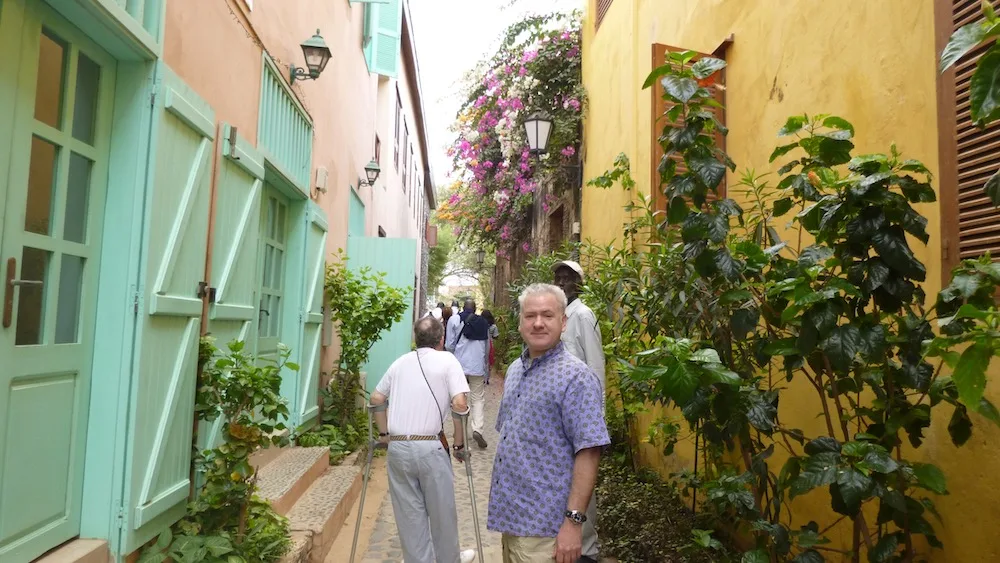
Lunch at one of cafés near the ferry dock is scenic and relaxing. My companions had the usual grilled chicken, grilled fish and rice. I had chicken in a mild-spiced peanut sauce, a very typical local dish that I liked a lot. It’s similar to Thai saté, but it’s a thinner sauce with a little more seasoning.
Tip: You don’t need to stay overnight on Gorée, but it does have some small inns that might be worth a stay.
I imagine it’s one of those places that fills with tourists during the day and is lovely in an entirely different way when everyone leaves in the late afternoon and you and the locals have it to yourselves.
Another Idea: Another UNESCO site, St. Louis is a charming colonial port city north of Dakar. It has an interesting history. Some of it is tangential to the slave trade and there is much more besides.
Unfortunately it was out of our reach in the time we had. But it’s common to pair St. Louis with a visit to Djoudj National Park, a bird sanctuary similar to Sine-Saloum.
Visit a Game Preserve
We spent a day at Bandia Reserve, a sprawling game park 45 minutes from Dakar with animals from across Africa. It was wilder than a zoo with all of the animals roaming free wherever they want to. But it’s more contained than a safari so you have a good chance (though no guarantee) and seeing most of the kinds of animals that live there.
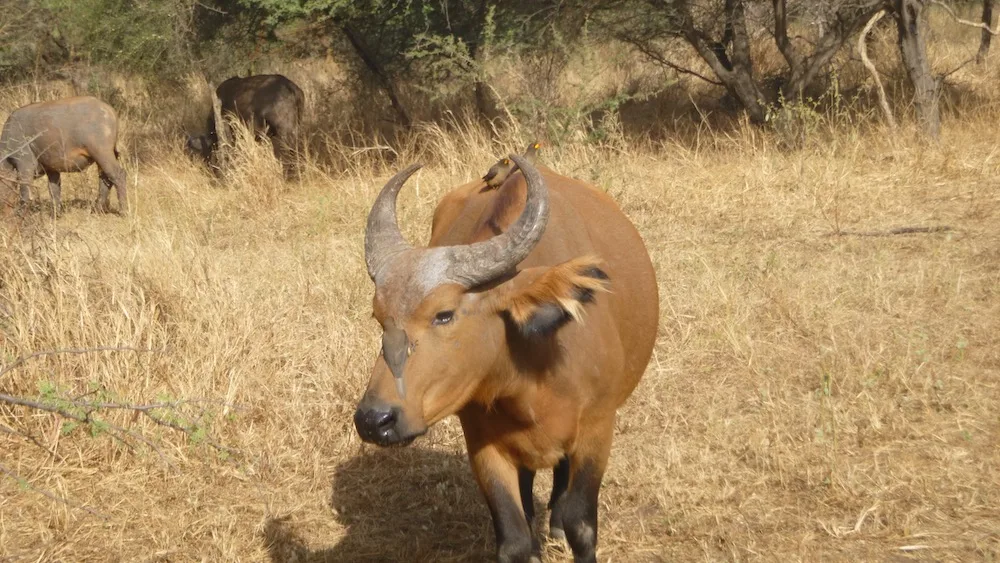
We saw giraffes, zebras, wart hogs, élans, gazelles, monkeys and even two elusive black rhinos, that the guides often can’t find. We saw many of these creatures from as little as 15 feet away, which was pretty amazing. We also saw one of tallest baobab trees of our trip.
You need a four-wheel-drive truck in the park and a guide that they provide. You can either bring your own truck or catch a ride on one of theirs, which carries about a dozen people. Being on your own is better because you have the most flexibility to take as much time as seek out plenty of animals. But the group carriers looked like they don’t contain a too-large group of people.
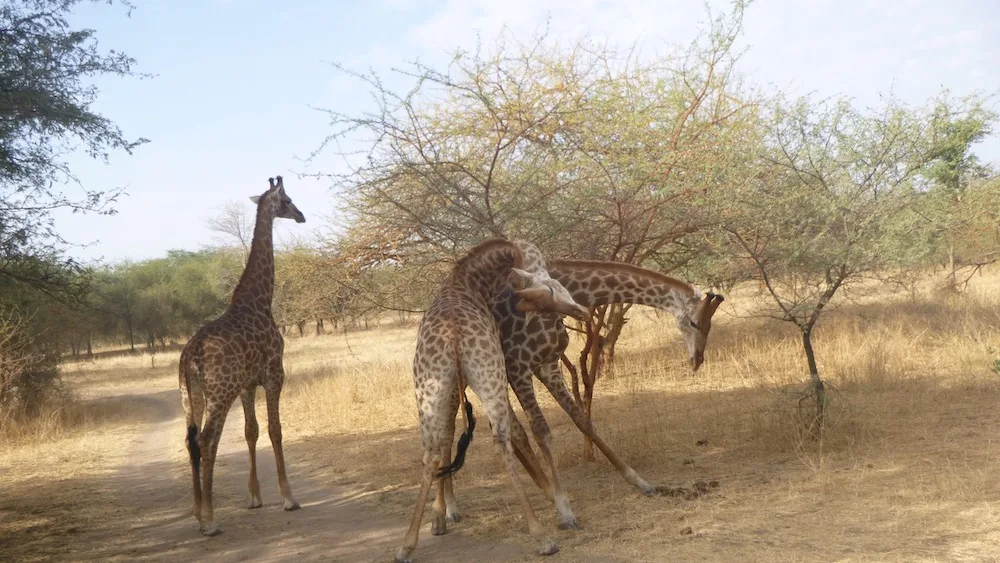
Snack Time: Bandia has a lovely outdoor restaurant overlooking a watering hole full of crocodiles and a troop of monkeys across the pond. The food is expensive by local standards and we didn’t eat there. Even if you don’t eat, it’s a scenic and worthwhile spot to cool off with a Coke or a beer (or maybe an ice cream) after your dusty trip around the park.
There are larger reserves and national parks that you can explore further inland if you are on a longer trip. For us, Bandia was convenient and well worth doing; we definitely saw animals here we’d never seen before and familiar animals in larger herds than any zoo would have.
Read About: 13 Amazing Zoos Around the World
Go to the fish market
We visited the outdoor fish market in Mbour late one afternoon when the giant wooden pirogues were returning with their catch.
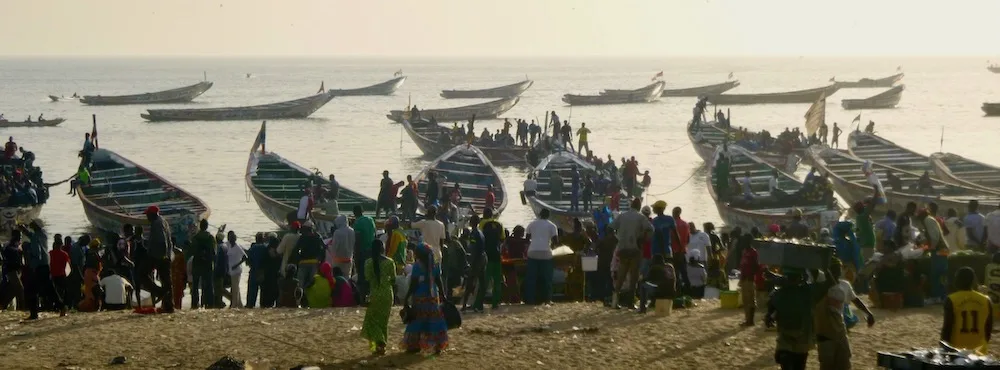
It was an amazing sight. The boats were colorful and a whole group coming back to shore together ws quite picturesque.
In addition to the boats there was the colorful local garb, the wooden donkey carts and large hand baskets for ferrying the fish up to the market pavilion and the hawkers selling their wares and cutting fish to order. It was crowded, hectic and smelly—and not something you see every day.
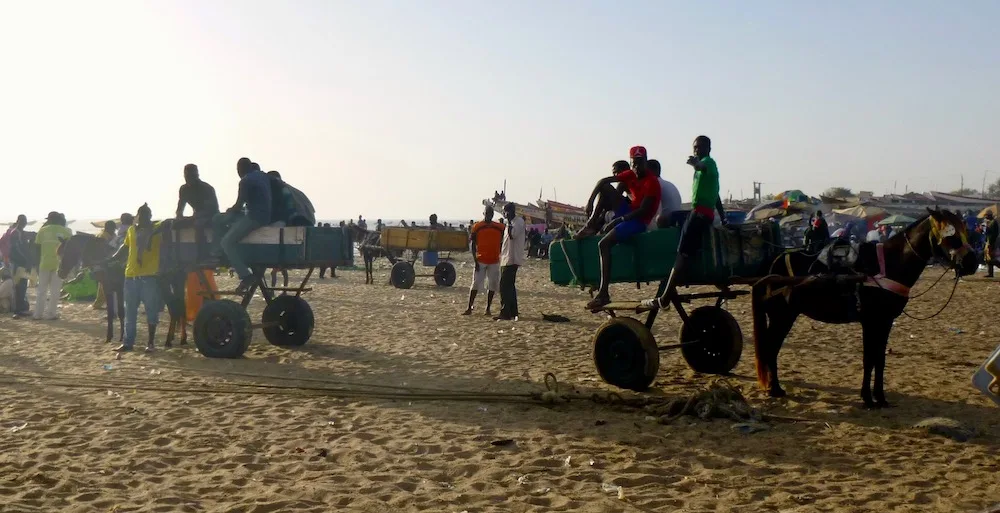
Individuals can’t walk around the market on their own. But you can hire a guide to take you around. If you have the opportunity, do it.
There’s a similar market in St. Louis.
Tip: I sort of joke about the fact that Rich and our host had grilled fish for lunch pretty much every day. And we always had fish for dinner, too.
But we were on the coast and if there’s fish on the menu it’s fresh. And really, all you need to do is season it a bit and grill or flash-fry it. Grilled giant shrimp, curried small shrimp and stewed calamari are easy to come by, too.
The national dish is Thiéboudienne, a meaty fish stuffed with spices and cooked in a big pot with root vegetables. It wasn’t my favorite meal. But it’s so typical of the region (neighboring countries have their variations) that if you have the opportunity you really have to try it.
Enjoy some beach time
French people go to Senegal for affordable beach getaways on the long stretches of sand around Saly, Mbour Nianing and Mbodiene. And indeed, Senegal’s coast has long stretches of yellow-sand beaches and a mellow surf that isn’t too cold.
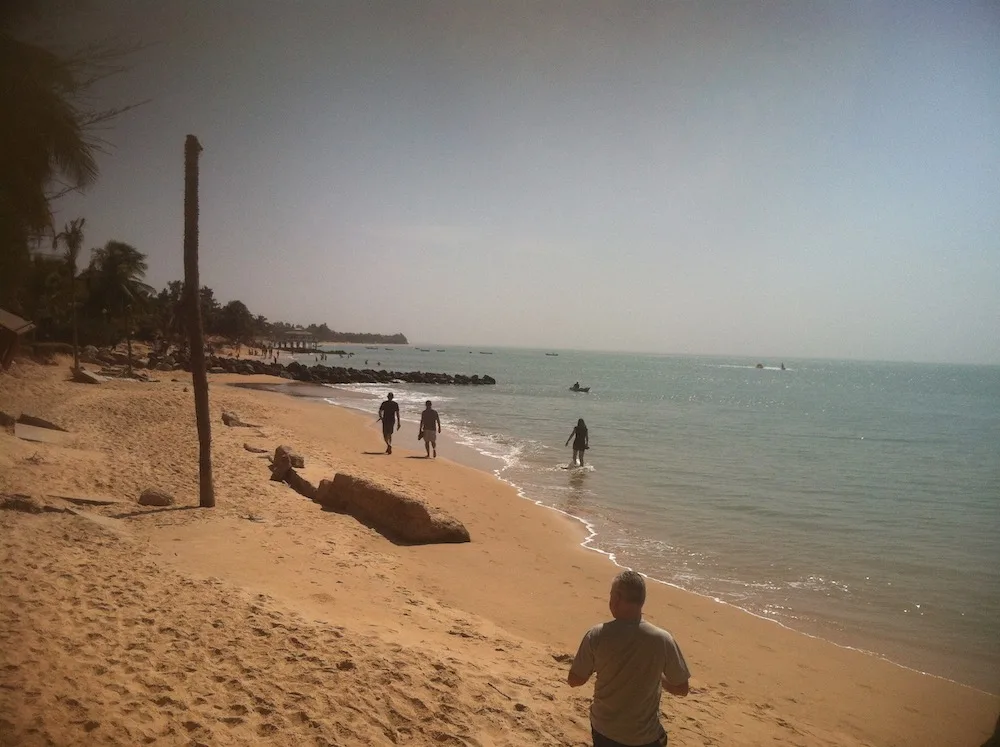
We took a walk along the beach one day in Mbour and had lunch at a local hotel. It’s typical on most beaches to see small fishing boats going in and out. You’ll also see groups of men fishing from shore with enormous nets.
It was nice to see what a hotel option would look like. It was a picturesque boutique resort with a small pool, comfortable lounge chairs, and a stone patio with a covered outdoor bar and a restaurant serving a mix of local and French food.
Some hotels are bigger than this one and pools vary in size. But it was fairly typical of the beach-side hotels here. It’s pretty easy to find quality small resorts that charge from $100 to $200 a night.
I would recommend basing yourself at one of the beaches rather than in Dakar. It’s not an attractive city and it’s hectic to drive in and out of it every day for excursions. You can always take a day tour of Dakar to get a feel for the city.
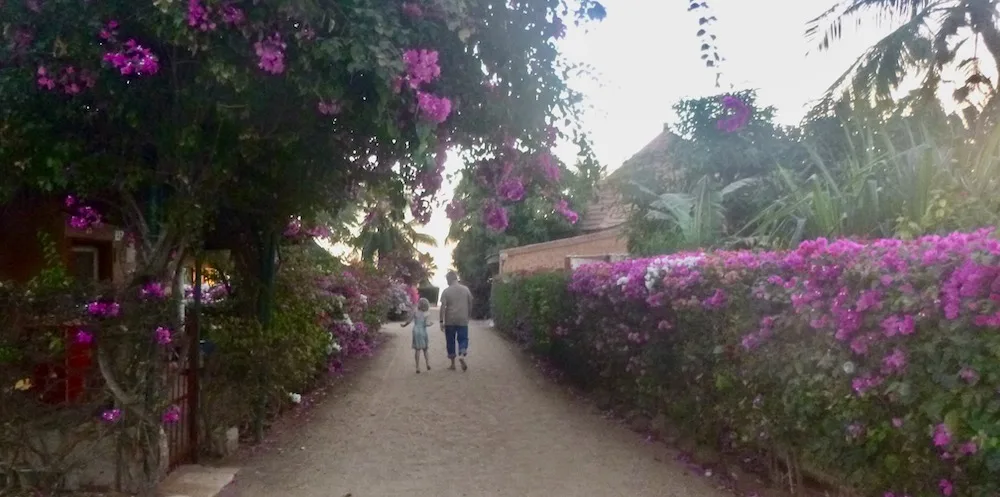
We stayed in a vacation-home enclave in Saly, which was convenient to all the activities we did. It had its own pool and the community was next to the beach. Since every excursion left us hot and covered in dust it was nice to jump in the ocean before dinner.
Take home some local art
Artwork, such as ebony statues and dishware, hand-carved jewelry, baobab bowls and dishes, and wall art made with sand, paint or ink, are the best things to bring back as souvenirs. You’ll find small artisan markets on the beach and near most tourist activities.
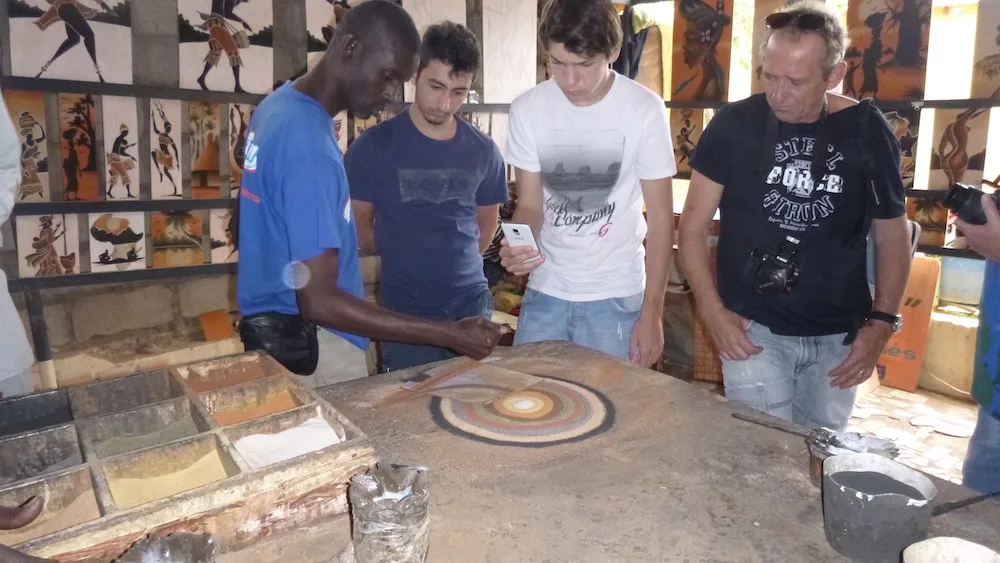
The giant hill that winds up from docks in Gorée is a sloping outdoor gallery, with genuinely interesting things. We bought a canvas with giant hand-painted butterfly to hang in Tiny Traveler’s room. Ten years later, we still love it.
Look for the studio that gathers different shades of sand from across Africa and creates beautiful pictures with them. It’s a unique and affordable way to remember your trip.
Basic Information About Senegal
Getting to Dakar
Our direct flights on Delta between New York and Dakar were about eight hours out and nine on the return trip. This is half as far as the Safari destinations in Southern Africa. In fact, many flights to those further points stop in Senegal to refuel.
All the departing flights to Europe and the U.S. leave very late at night, around midnight or 1:00 AM. It was a little odd getting to the airport that late. But the upside was that Tiny Traveler fell asleep almost as soon as the plane took off and got a full night’s rest. This definitely helped her get over the jetlag easily.
Money & Shopping in Senegal
You can find comfortable, quality hotels for well under $200 a night.
Main dishes in restaurants were never more than $15. On all of our day trips we ate at either the only restaurant available (Lac Rose) or the restaurant that was busy with food that looked good (Ile de Gorée). The food was always similar: grilled chicken and fish and curried shrimp or goat were common. It was never fancy but it was always freshly made and good.
You won’t see hard liquor outside of the hotels that cater to Europeans, but the Senegalese drink beer. Local brands are easy to come by and inexpensive.
In Saly and Mbour you can find French supermarkets with all the basics you might need. Nutella was less expensive than here so we brought home a couple of jars.
You’ll quickly know what kinds of fruit are in season because there will be roadside stands with people selling piles of them inexpensively. When we were there it was watermelon.
Shopping for local crafts was fun. Some of the artisans were willing to bargain and some weren’t. You can always try, but let it go if they’re not interested.
Bandia was by far our most expensive outing. We hired our own four-wheel-drive truck and driver. At the park we paid for the requisite park guide plus vehicle fee and admission for four adults and one child. With drinks at the café the total tab today would be $150-$200. You make it easy on yourself and book a tour that includes all of that.
Safety in Senegal
Senegal has been a democracy since the 1960s and is considered to be tourist friendly and safe. People are predominantly Muslim but not overly conservative. Boys and girls are educated equally.
Intermarriage with the country’s small Catholic population is accepted. The pretty island town of Fadiout, with its scenic mixed-faith cemetery is the most interesting example of this commingling.
It does border Mali and Mauritania, but there’s nothing that would bring tourists close to those borders and their troubles haven’t spilled over.
During the summer rainy season it pours for three months and roads can be impassable. Definitely visit during dry season—Late September to late May.
For more advice, you can read our post on preparing for this trip.
What to wear in Senegal
Local women were almost exclusively in ankle-length dresses that were stylish and colorful. Many girls wore similar dresses to the women. Men were slack and young boys wore shorts.
Our activities weren’t conducive to below-knees skirts so I mostly wore capris and light shirts with three-quarter or short sleeves, both to be appropriate and provide sun protection. Tiny Traveler wore sundresses, which was fine. Shorts are acceptable at the resorts, but I wouldn’t wear them sightseeing.
Driving (or Rather, Not Driving) in Senegal
The roads we traveled were mostly paved and in reasonable condition. But outside of Dakar there wasn’t a stop sign or traffic light to be seen. Cars, trucks and buses are in dubious condition, so breakdowns and accidents routinely stall traffic. Also, the roads are mostly two-lanes. Give yourself far more time than you think to get places.
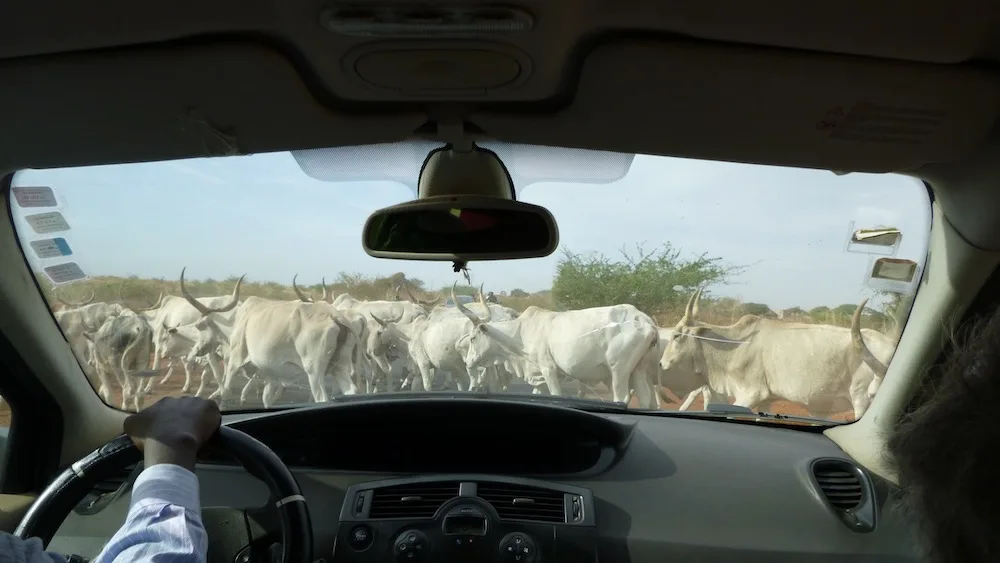
Traffic is the most congested getting into and out of Dakar. More accidents happen at night. When you get on to the back roads herds or cows or goats can slow you down.
I would highly recommend hiring a driver for the length of your stay. It’s not going to be very expensive. And it will make things so much easier if you have someone who knows the rules of the road, the detours, how to get places and driving times. Your hotel or travel company can help you engage someone reliable.
How about the bus? Long distance buses and vans are common and very inexpensive. But they don’t leave until they’re full (or until all seats have been paid for) so expect them to always be crowded. Take them if you’re adventurous and have ample time and patience.
If your child needs a car seat, bring a portable one, like a Bubble Bum or Hiccapop and hope the cars you use have seatbelts. They very well might not, so don’t put in the effort of schlepping a proper car seat.
We waited until Tiny Traveler was 7 or 8 to take this trip partly because I thought I’d find the seat-belt/car-seat situation easier to handle than I would have when she was smaller.
Pin it for later!
